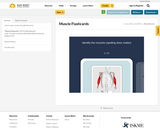
Hank describes mitosis and cytokinesis - the series of processes our cells go through to divide into two identical copies.
- Subject:
- Biology
- Science
- Material Type:
- Activity/Lab
- Author:
- Crashcourse
- Date Added:
- 01/31/2019

Hank describes mitosis and cytokinesis - the series of processes our cells go through to divide into two identical copies.

One strand of the DNA is used as a template to create an mRNA copy. This process is called transcription. An mRNA copy needs to be made because DNA cannot leave the nucleus. Protein complexes separate the DNA helix to allow complementary mRNA nucleotides to bind to the DNA sequence. The pairing of nucleotides is very specific. Use the A, U, G and C buttons to place the correct mRNA nucleotide with each DNA nucleotide.

Students will breed fruit flies through several generations and record their data using mathematical models in order to demonstrate the inheritance of trait variations.

Developed for second grade. Students will first hypothesize whether wheat bread or white bread will grow more mold. They will test the hypothesis using a simple and inexpensive set up. Bread will be placed in a plastic bag to be observed and never opened. Students will measure mold on a daily basis and record the data to graph later. Students will analyze the results when the experiment is complete.Biology In Elementary Schools is a Saint Michael's College student project. The teaching ideas on this page have been found, refined, and developed by students in a college-level course on the teaching of biology at the elementary level. Unless otherwise noted, the lesson plans have been tried at least once by students from our partner schools. This wiki has been established to share ideas about teaching biology in elementary schools. The motivation behind the creation of this page is twofold: 1. to provide an outlet for the teaching ideas of a group of college educators participating in a workshop-style course; 2. to provide a space where anyone else interested in this topic can place their ideas.

Developed for first grade. Students will begin by being introduced to the food pyramid. This will include a coloring activity to emphasize the different food groups. Next, students will take part in an experiment showing the process of growing mold on food.Biology In Elementary Schools is a Saint Michael's College student project. The teaching ideas on this page have been found, refined, and developed by students in a college-level course on the teaching of biology at the elementary level. Unless otherwise noted, the lesson plans have been tried at least once by students from our partner schools. This wiki has been established to share ideas about teaching biology in elementary schools. The motivation behind the creation of this page is twofold: 1. to provide an outlet for the teaching ideas of a group of college educators participating in a workshop-style course; 2. to provide a space where anyone else interested in this topic can place their ideas.

Learns major muscles through flashcards.

In this video we take a look at the best ways to study the muscular system.
Lesson 8 in our Muscular System series. This is part of our Anatomy and Physiology lecture series.
If this video helps you please be sure to LST -like subscribe and tell your friends. Your support help us make more videos. For the complete series please visit http://mrfordsclass.net/
Videos in the skeletal system series:
-Muscle Tissue (09:01): http://youtu.be/RDqUg7ERwDQ
-Skeletal Muscle (09:02): http://youtu.be/NBuReVewhws
-Motor Unit and Muscle Fibers (09:03): http://youtu.be/f5wnaf96TH4
-Cardiac and Smooth Muscle (09:04): http://youtu.be/isOWu7Ts-vs
-Introduction to the Muscular System (09:05): http://youtu.be/F8DzB7hcLA4
-Fascia (09:06): http://youtu.be/K1zkJySBhlU
-Types of Muscle Contraction (09:07): http://youtu.be/i2VG3HGBrBw
-Before We Start (09:08): http://youtu.be/HXH7tQ2Cq1o
-Muscles of Facial Expression (09:09): http://youtu.be/UB73SMxDv-o
-Muscles of Mastication (09:10): http://youtu.be/oOiUJ6b6-pI

Moving from the histology of skeletal muscle, now we need to know about cardiac muscle tissues and smooth muscle tissue.
Lesson 3 in our Muscular System series. This is part of our Anatomy and Physiology lecture series.
If this video helps you please be sure to LST -like subscribe and tell your friends. Your support help us make more videos. For the complete series please visit http://mrfordsclass.net/
Videos in the skeletal system series:
-Muscle Tissue (09:01): http://youtu.be/RDqUg7ERwDQ
-Skeletal Muscle (09:02): http://youtu.be/NBuReVewhws
-Motor Unit and Muscle Fibers (09:03): http://youtu.be/f5wnaf96TH4
-Cardiac and Smooth Muscle (09:04): http://youtu.be/isOWu7Ts-vs
-Introduction to the Muscular System (09:05): http://youtu.be/F8DzB7hcLA4
-Fascia (09:06): http://youtu.be/K1zkJySBhlU
-Types of Muscle Contraction (09:07): http://youtu.be/i2VG3HGBrBw
-Before We Start (09:08): http://youtu.be/HXH7tQ2Cq1o
-Muscles of Facial Expression (09:09): http://youtu.be/UB73SMxDv-o
-Muscles of Mastication (09:10): http://youtu.be/oOiUJ6b6-pI

No conversation about the muscular system is compete without looking at fascia. In this lecture we look at the structure and function of this often unappreciated structure.
Lesson 6 in our Muscular System series. This is part of our Anatomy and Physiology lecture series.
If this video helps you please be sure to LST -like subscribe and tell your friends. Your support help us make more videos. For the complete series please visit http://mrfordsclass.net/
Videos in the skeletal system series:
-Muscle Tissue (09:01): http://youtu.be/RDqUg7ERwDQ
-Skeletal Muscle (09:02): http://youtu.be/NBuReVewhws
-Motor Unit and Muscle Fibers (09:03): http://youtu.be/f5wnaf96TH4
-Cardiac and Smooth Muscle (09:04): http://youtu.be/isOWu7Ts-vs
-Introduction to the Muscular System (09:05): http://youtu.be/F8DzB7hcLA4
-Fascia (09:06): http://youtu.be/K1zkJySBhlU
-Types of Muscle Contraction (09:07): http://youtu.be/i2VG3HGBrBw
-Before We Start (09:08): http://youtu.be/HXH7tQ2Cq1o
-Muscles of Facial Expression (09:09): http://youtu.be/UB73SMxDv-o
-Muscles of Mastication (09:10): http://youtu.be/oOiUJ6b6-pI

In this video we take a quick overview of the muscular system and talk about the functions of the skeletal muscles.
Lesson 5 in our Muscular System series. This is part of our Anatomy and Physiology lecture series.
If this video helps you please be sure to LST -like subscribe and tell your friends. Your support help us make more videos. For the complete series please visit http://mrfordsclass.net/
Videos in the skeletal system series:
-Muscle Tissue (09:01): http://youtu.be/RDqUg7ERwDQ
-Skeletal Muscle (09:02): http://youtu.be/NBuReVewhws
-Motor Unit and Muscle Fibers (09:03): http://youtu.be/f5wnaf96TH4
-Cardiac and Smooth Muscle (09:04): http://youtu.be/isOWu7Ts-vs
-Introduction to the Muscular System (09:05): http://youtu.be/F8DzB7hcLA4
-Fascia (09:06): http://youtu.be/K1zkJySBhlU
-Types of Muscle Contraction (09:07): http://youtu.be/i2VG3HGBrBw
-Before We Start (09:08): http://youtu.be/HXH7tQ2Cq1o
-Muscles of Facial Expression (09:09): http://youtu.be/UB73SMxDv-o
-Muscles of Mastication (09:10): http://youtu.be/oOiUJ6b6-pI

Lean what the motor unit is and how it makes muscles fibers contract.
Lesson 3 in our Muscular System series. This is part of our Anatomy and Physiology lecture series.
If this video helps you please be sure to LST -like subscribe and tell your friends. Your support help us make more videos. For the complete series please visit http://mrfordsclass.net/
Videos in the skeletal system series:
-Muscle Tissue (09:01): http://youtu.be/RDqUg7ERwDQ
-Skeletal Muscle (09:02): http://youtu.be/NBuReVewhws
-Motor Unit and Muscle Fibers (09:03): http://youtu.be/f5wnaf96TH4
-Cardiac and Smooth Muscle (09:04): http://youtu.be/isOWu7Ts-vs
-Introduction to the Muscular System (09:05): http://youtu.be/F8DzB7hcLA4
-Fascia (09:06): http://youtu.be/K1zkJySBhlU
-Types of Muscle Contraction (09:07): http://youtu.be/i2VG3HGBrBw
-Before We Start (09:08): http://youtu.be/HXH7tQ2Cq1o
-Muscles of Facial Expression (09:09): http://youtu.be/UB73SMxDv-o
-Muscles of Mastication (09:10): http://youtu.be/oOiUJ6b6-pI

Welcome to the Muscular System! In this video we look at the histology of skeletal muscle tissue and the functions of skeletal muscle.
Lesson 1 in our Muscular System series. This is part of our Anatomy and Physiology lecture series.
If this video helps you please be sure to LST -like subscribe and tell your friends. Your support help us make more videos. For the complete series please visit http://mrfordsclass.net/
Videos in the skeletal system series:
-Muscle Tissue (09:01): http://youtu.be/RDqUg7ERwDQ
-Skeletal Muscle (09:02): http://youtu.be/NBuReVewhws
-Motor Unit and Muscle Fibers (09:03): http://youtu.be/f5wnaf96TH4
-Cardiac and Smooth Muscle (09:04): http://youtu.be/isOWu7Ts-vs
-Introduction to the Muscular System (09:05): http://youtu.be/F8DzB7hcLA4
-Fascia (09:06): http://youtu.be/K1zkJySBhlU
-Types of Muscle Contraction (09:07): http://youtu.be/i2VG3HGBrBw
-Before We Start (09:08): http://youtu.be/HXH7tQ2Cq1o
-Muscles of Facial Expression (09:09): http://youtu.be/UB73SMxDv-o
-Muscles of Mastication (09:10): http://youtu.be/oOiUJ6b6-pI

This video covers the muscles of facial expression.
Special thanks to Visible Body for allowing me to use screen captures of their amazing product.
Lesson 9 in our Muscular System series. This is part of our Anatomy and Physiology lecture series.
If this video helps you please be sure to LST -like subscribe and tell your friends. Your support help us make more videos. For the complete series please visit http://mrfordsclass.net/
Videos in the skeletal system series:
-Muscle Tissue (09:01): http://youtu.be/RDqUg7ERwDQ
-Skeletal Muscle (09:02): http://youtu.be/NBuReVewhws
-Motor Unit and Muscle Fibers (09:03): http://youtu.be/f5wnaf96TH4
-Cardiac and Smooth Muscle (09:04): http://youtu.be/isOWu7Ts-vs
-Introduction to the Muscular System (09:05): http://youtu.be/F8DzB7hcLA4
-Fascia (09:06): http://youtu.be/K1zkJySBhlU
-Types of Muscle Contraction (09:07): http://youtu.be/i2VG3HGBrBw
-Before We Start (09:08): http://youtu.be/HXH7tQ2Cq1o
-Muscles of Facial Expression (09:09): http://youtu.be/UB73SMxDv-o
-Muscles of Mastication (09:10): http://youtu.be/oOiUJ6b6-pI

This video covers the muscles of mastication.
Special thanks to Visible Body for allowing me to use screen captures of their amazing product.
Lesson 10 in our Muscular System series. This is part of our Anatomy and Physiology lecture series.
If this video helps you please be sure to LST -like subscribe and tell your friends. Your support help us make more videos. For the complete series please visit http://mrfordsclass.net/
Videos in the skeletal system series:
-Muscle Tissue (09:01): http://youtu.be/RDqUg7ERwDQ
-Skeletal Muscle (09:02): http://youtu.be/NBuReVewhws
-Motor Unit and Muscle Fibers (09:03): http://youtu.be/f5wnaf96TH4
-Cardiac and Smooth Muscle (09:04): http://youtu.be/isOWu7Ts-vs
-Introduction to the Muscular System (09:05): http://youtu.be/F8DzB7hcLA4
-Fascia (09:06): http://youtu.be/K1zkJySBhlU
-Types of Muscle Contraction (09:07): http://youtu.be/i2VG3HGBrBw
-Before We Start (09:08): http://youtu.be/HXH7tQ2Cq1o
-Muscles of Facial Expression (09:09): http://youtu.be/UB73SMxDv-o
-Muscles of Mastication (09:10): http://youtu.be/oOiUJ6b6-pI

In this video we take a closer look at the histology of skeletal muscle and the sarcomere.
Lesson 2 in our Muscular System series. This is part of our Anatomy and Physiology lecture series.
If this video helps you please be sure to LST -like subscribe and tell your friends. Your support help us make more videos. For the complete series please visit http://mrfordsclass.net/
Videos in the skeletal system series:
-Muscle Tissue (09:01): http://youtu.be/RDqUg7ERwDQ
-Skeletal Muscle (09:02): http://youtu.be/NBuReVewhws
-Motor Unit and Muscle Fibers (09:03): http://youtu.be/f5wnaf96TH4
-Cardiac and Smooth Muscle (09:04): http://youtu.be/isOWu7Ts-vs
-Introduction to the Muscular System (09:05): http://youtu.be/F8DzB7hcLA4
-Fascia (09:06): http://youtu.be/K1zkJySBhlU
-Types of Muscle Contraction (09:07): http://youtu.be/i2VG3HGBrBw
-Before We Start (09:08): http://youtu.be/HXH7tQ2Cq1o
-Muscles of Facial Expression (09:09): http://youtu.be/UB73SMxDv-o
-Muscles of Mastication (09:10): http://youtu.be/oOiUJ6b6-pI

In this video we take a look at the types of muscle contractions: isometric, isotonic, concentric, and eccentric. We also cover the relationship muscles have with each other, specifically the agonist, synergists, antagonist, and fixator.
Lesson 7 in our Muscular System series. This is part of our Anatomy and Physiology lecture series.
If this video helps you please be sure to LST -like subscribe and tell your friends. Your support help us make more videos. For the complete series please visit http://mrfordsclass.net/
Videos in the skeletal system series:
-Muscle Tissue (09:01): http://youtu.be/RDqUg7ERwDQ
-Skeletal Muscle (09:02): http://youtu.be/NBuReVewhws
-Motor Unit and Muscle Fibers (09:03): http://youtu.be/f5wnaf96TH4
-Cardiac and Smooth Muscle (09:04): http://youtu.be/isOWu7Ts-vs
-Introduction to the Muscular System (09:05): http://youtu.be/F8DzB7hcLA4
-Fascia (09:06): http://youtu.be/K1zkJySBhlU
-Types of Muscle Contraction (09:07): http://youtu.be/i2VG3HGBrBw
-Before We Start (09:08): http://youtu.be/HXH7tQ2Cq1o
-Muscles of Facial Expression (09:09): http://youtu.be/UB73SMxDv-o
-Muscles of Mastication (09:10): http://youtu.be/oOiUJ6b6-pI

Students perform an activity similar to the childhood “telephone” game in which each communication step represents a biological process related to the passage of DNA from one cell to another. This game tangibly illustrates how DNA mutations can happen over several cell generations and the effects the mutations can have on the proteins that cells need to produce. Next, students use the results from the “telephone” game (normal, substitution, deletion or insertion) to test how the mutation affects the survivability of an organism in the wild. Through simple enactments, students act as “predators” and “eat” (remove) the organism from the environment, demonstrating natural selection based on mutation.

Students learn about mutations to both DNA and chromosomes, and uncontrolled changes to the genetic code. They are introduced to small-scale mutations (substitutions, deletions and insertions) and large-scale mutations (deletion duplications, inversions, insertions, translocations and nondisjunctions). The effects of different mutations are studied as well as environmental factors that may increase the likelihood of mutations. A PowerPoint® presentation and pre/post-assessments are provided.

Mutations are mistakes in the DNA sequence. Use the Edit DNA button to change the entire sequence or click on an individual nucleotide to make an insertion, deletion or substitution mutation. How does changing the DNA sequence change the resulting protein? You can quickly jump between the DNA sequence and final protein by using the Show DNA and Show protein buttons. Are some types of mutations more damaging than others?

The educational resources you find here are for Indigenous and non-Indigenous educators teaching students and learners of all ages.
Here, you will find:
Lesson plans developed with an Indigenous perspective for teaching:
-Indigenous, land-based skills and knowledge;
-Indigenous languages;
-Mainstream K-12 subjects infused with Indigenous knowledge.
Some lesson plans are adaptable for professional development opportunities.
Videos that can be used as part of lesson plans or on their own.
Helpful materials for educators to:
-Evaluate your and your learners’ experiences with a lesson;
-Create your own lesson plans using templates with an Indigenous-based, student-centered approach.
Find lesson plans in: Indigenous Languages, Indigenous Ways of Knowing and Being, On the Land, Art, Music, Commerce or Business, Careers, Science, Biology, Math, Nutrition, Family and Parenting, History, Social Studies.